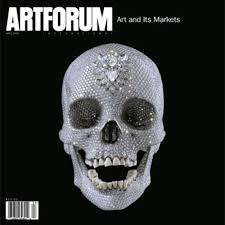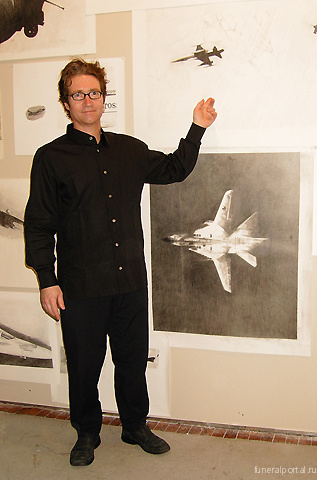
Joseph Bartscherer, Pioneering Mattawa. Nectarine, 1984–94, gelatin silver print, selenium toned, 23 7/16 x 28 7/16". Courtesy Peter Freeman, Inc. © the artist.
THE DAY AFTER I LEARNED Joseph Bartscherer had died, I opened the New York Times Magazine to a feature on the seasonal workers who harvest cherries in the same Mattawa, Washington, orchards that Joseph photographed thirty-five years earlier for “Pioneering Mattawa,” 1984–92, a series undertaken in a former desert expanse two and a half hours north of Seattle. The magazine’s freelancer Jovelle Tamayo chose to partially shoot the cherry trees during the foggy morning hours, making somber, damp photographs. By contrast, Joseph’s images of these same vineyards and orchards shine with the sharp, arid light that ricochets off the sandy soil.
Bartscherer discovered photography at Harvard under the mentorship of Ben Lifson. He then pursued an MFA at the Nova Scotia College of Art and Design, where he was Robert Frank’s teaching assistant and where he participated in the experimental aesthetic that permeated the school in the 1970s. In the early 1990s, when Joseph and I worked in adjoining studios and darkrooms in SoHo, he told me about the special Beers developer that he used for “Pioneering Mattawa.” Beers is made from component chemicals, so that by varying the primary ingredients, metol and hydroquinone, the photographer can precisely control the light and dark values of the print. With this exacting protocol, Joseph was able to effect the microtonal adjustments that gave the series its exceptional clarity and definition.
In 1995, when Bartscherer showed “Pioneering Mattawa” in the Museum of Modern Art’s “New Photography 11,” the work was installed in grids three rows high and six columns wide. There were gaps in each grid, which created irregular zigzag patterns of landscape and empty space. As your eyes scanned the installation, you’d see apple trees flowering in one photograph and, a few images over, the same trees naked, surrounded by snow. In these open grids, the synapses between the prints encouraged the viewer to forge subtle associations between images.

The Mattawa project’s concerns with elemental cycles of life, death, and rebirth—and their interconnectedness—were perhaps thematized most complexly in Bartscherer’s largest work, Obituary, for which the artist collected hundreds of issues of the New York Times whose front pages featured photographs of someone obituarized inside. Begun in 1990 and still ongoing at the time of Joseph’s death, Obituary was first installed in groups of six complete newspapers, unfolded, faceup, on clear sheets of Plexiglas parallel to the floor. The eponymous content of Obituary, the shape of a human life, is condensed into a grayscale halftone or, after 1997, when the Times introduced color, a color halftone. To some, the readymade-ness of Obituary was a surprising step away from the alchemical wizardry of “Pioneering Mattawa.” When I spoke with Joseph in Bomb magazine a few years ago, he told me that the syncopated faces on the front pages of the Times reminded him of the similarly disparate pictorial elements he discovered and photographed in Mattawa. That the statistical regularity of death was locked up in a layout with the arcana of politics, national news, sports, and the weather was a source of great interest and visual enjoyment for him.
Obituary was exhibited at Marian Goodman Gallery and at the Davis Museum at Wellesley College, the latter opening a week before September 11, 2001. Arthur C. Danto, who wrote a catalogue essay for the Wellesley exhibition, commented later on the powerful resonance between the events of 9/11 and Obituary. Something of this resonance can be felt now in our current time of mourning and uncertainty.

In 1999, even as Obituary continued to evolve, Bartscherer embarked on Forest, a yearslong exploration of an old-growth woodland in southern New England. When I saw the work at Galerie Nelson-Freeman in 2006, I was surprised to find that the open-grid structure of “Pioneering Mattawa” was gone; this time, a matrix of color photographs was now completely filled in with pictures. In Forest, a dense and hilly pocket of land, marked with glacial erratics, swales, hills, and ponds, set the stage for the dynamic agon of nature that fascinated Bartscherer. Seasons pass; white pine, ash, maple, and beech compete for small patches of sunlight; flowering buds and new growth spring up next to storm-damaged trees. Life blooms against the backdrop of death. During our Bomb conversation, Joseph linked the forest’s life to that of his own: “My own mortality, my life story, was somehow paralleling the progress of mortality that’s inherent to the evolution of the forest.”
Joseph dove deep in Forest. Driven by his curiosity and boundless stamina, he returned again and again, year after year, to work with the visual density he encountered there. What he showed us was often tough and bracing. Joseph wasn’t making nice with nature when he photographed it; he wasn’t shifting his footing to improve his view. These are not pretty pictures. The stakes Bartscherer set for himself in Forest, and for his audience, were complex. He wanted to comprehend and represent and to somehow still the immense energy of this place, a quadrant of the biosphere almost completely devoid of human presence but teeming with vitality. This late work fits within the larger arc of Bartscherer’s creative life, a life lived to make sense of the world that excited his eyes and his intellect, using the full measure of his craft.
James Welling is a photographer based in New York.

Joseph Bartscherer https://www.peterfreemaninc.com/artists/joseph-bartscherer








